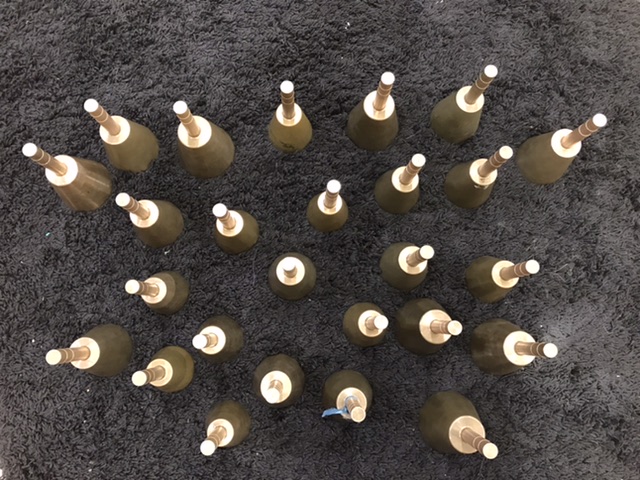… this Friday is our third Instrumental Music Assembly. It’s been a magical couple of weeks of imagination, sound, new ideas and singing. We have been finding out about the steel drum and the steel tongue drum, and expanding our palette of percussion and bell sounds to express our wonder about the galaxy. The School Choir is now in its sixth week and is sounding fabulous, and the whole school has started to learn songs for the Father’s and Special Carer’s Day Assembly in two weeks, and the Federation Bells/Percussion performance in Week 9.
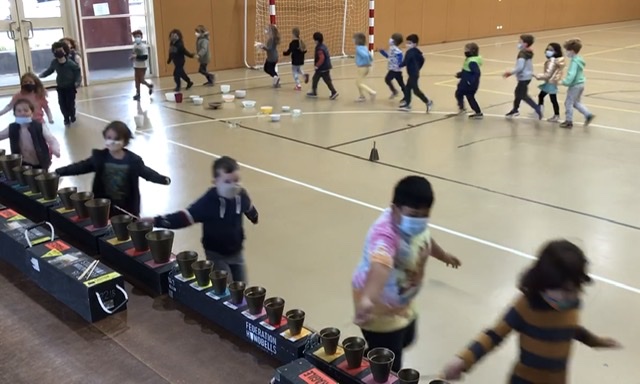
Students in the Instrumental Music program are looking forward to performing in assembly this Friday, and we are super proud to hear from some of this year’s Yr 2 beginners. All achievements in instrumental learning are building blocks to be celebrated, and there is a lot of learning happening, on multiple levels, when you step out on stage for the first time. For our Yr 6 students, this will be their last assembly performance in front of the whole school. Their performances are always inspiring for the younger students who learn so much by watching the ‘big kids’. Thanks to all the performers for sharing your learning. It is a great joy to celebrate your achievements as you grow through the IM program.
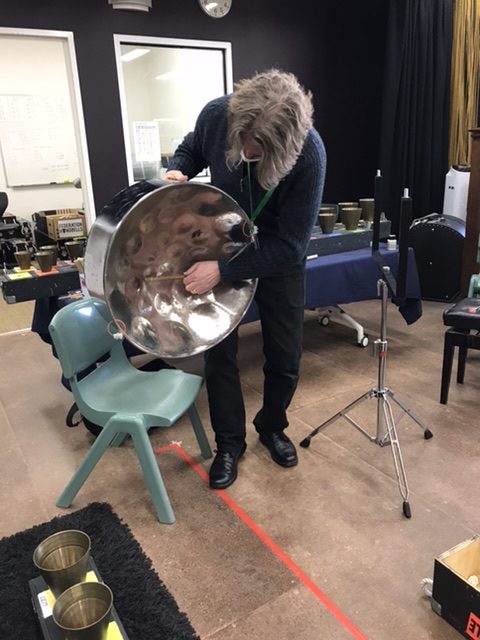
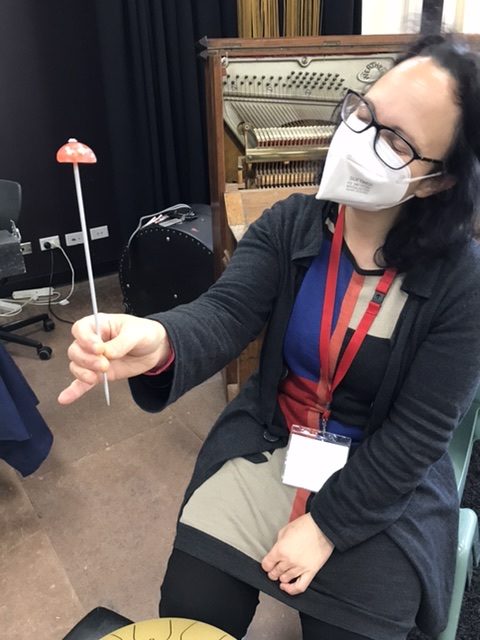
When Peter and Elissa performed an ’improv jam’ on the steel drum and the steel tongue drum the students said it sounded like we were at the beach! They also recognised the sound of the steel drum from the sound track to the film ’The Little Mermaid’. These connections are no accident as the steel drum creates a sound world that is the heart of the great carnivals in the Caribbean. The steel drum, as we know it today, was formally invented by Ellie Mannette in the 1950s, and grew out of the tradition of banging trash can lids, steel cans and drums in the streets at Carnival time in the early 20th Century. Excluded from the grand Carnival itself, the poorer people of Trinidad took to the streets to celebrate in their own carnival with the exuberant racket of scrap steel homemade instruments. It is fantastic that the steel drum emerged from this tradition and that Trinidad is proud to name it as their national instrument.
There are massive steel drum orchestral competitions every year, and this instrument has taken the world by storm as the quintessential street party sound. However, Peter also created sounds in the steel drum that students said sounded like atoms (Zara Yr 2) and the orbiting of planets around the sun, or, ’Beam me up Scotty’ from Star Trek (Chris Yr 5/6). By swirling marbles around in the pan of the steel drum a magical sound of all the pitches emerged beneath the rolling marble clatter. It was like a sound kaleidoscope. Now, we want to roll marbles around in everything! Peter and some Yr 5/6 students worked with the steel drum and the steel tongue drums to find ways of describing the Butterfly Cluster, a cluster of stars that orbits closely to the Black Hole.
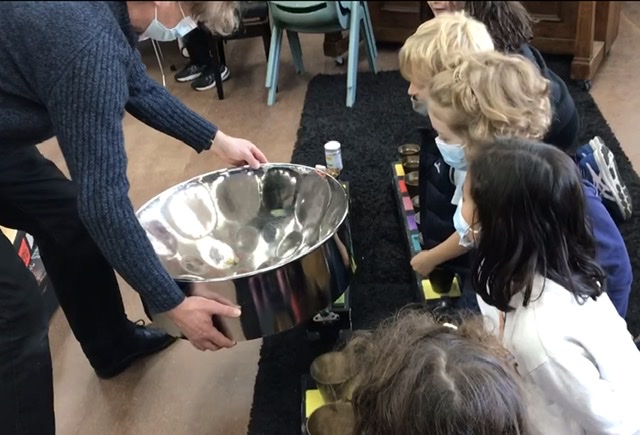
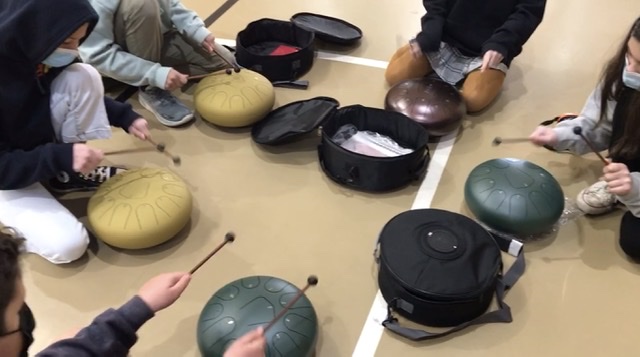
on the steel tongue drum
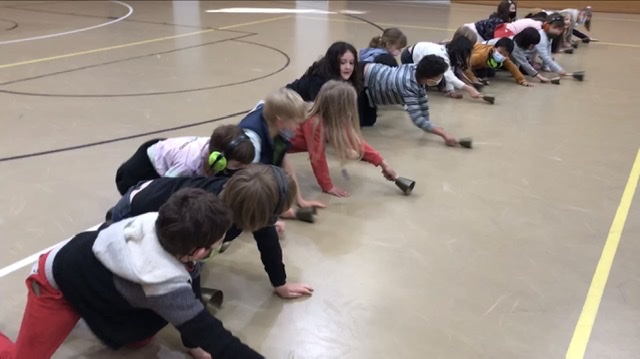
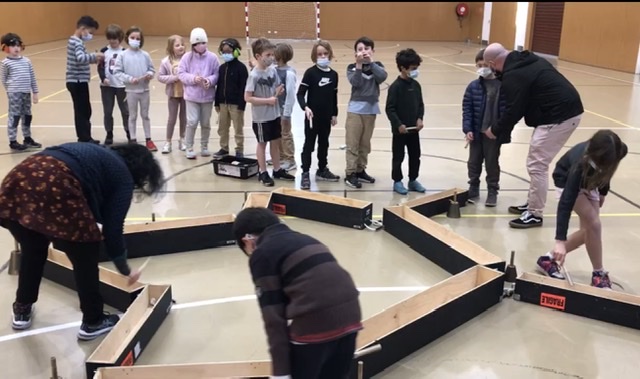
The Yr 2 Neighbourhood has chosen to connect their bell and percussion sounds to their understandings of Indigenous Astronomy. We have found that indigenous cultures across the world have understood the impact of the moon’s gravitational pull on water: the seas and oceans, and the rising and falling of sap in plants. Through observation, indigenous people knew that the best times to fish were when the tides were at their most calm and the waters were clear. Fish could see the fishing lures. These calm ‘neap tides’ occur when the moon is in it’s quarter and three quarter phases. King tides happen when the moon is full and orbiting closest to earth. These tides are higher than the usual high tides of the full moon and the new moon, and the seas are rough and full of stirred up sand. Fish stay far out to sea to avoid being dashed on the reefs. As sea levels rise with climate change, we are aware of the impact of king tides on island communities. By sliding the rim of a handbell on the gym floor the students achieved a sound of friction with a whisp of pitch. The faster we moved the bells, the rougher our imagined tides became.
In their Galaxy Parade exploration, the Yr 1s discovered 16 different things in their galaxy which all had distinctive sounds. They have voted in their top six favourites, and although the ‘Galaxy Ice Cream Truck’ didn’t have the numbers to be included, it did sound amazing. I won’t give the game away just yet, but some of the top six choices are yet to be discovered by astronomers. Watch this space (ouch!), or better yet, experience the parade live on September 7th.
And… we have been singing! Each year level is learning a creation story verse from Björk’s song ‘Cosmogony’, and we are revisiting an old favourite from pre-COVID times with ’Can’t Help Falling in Love’ as sung by Elvis Presley. The Indigenous American story Björk includes in her song tells of how the universe was once an empty sea…
‘And they say, back then, our universe, was an empty sea, until a silver fox and her cunning mate began to sing, a song that became the world we know.’
I am absolutely loving the interdisciplinary learning that the students are freely engaging in. It really feels like the more we find connections between what we know, the more whole and integrated we are as individuals, and this extends beyond ourselves to our community, and we hope, to the world as a whole. The Australian Indigenous concept of the ’Cosmoscape’ is nurturing, wise and wonderful: the land, the sea and the skies are one cosomoscape, all connected and needing to be in harmony. Thank you everyone for the joy and wonder of what we have shared these past two weeks. Cheerio, Deb.
